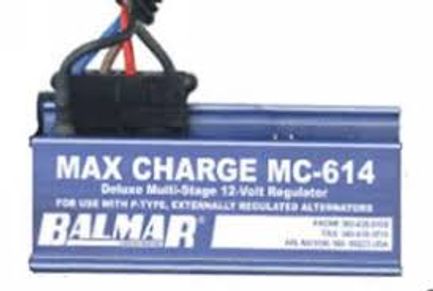Alternator Regulators
When pumping a bicycle tyre, it is at first easy to pump in the air. As there is no air pressure in the tyre to begin with, even a low pressure in the pump will cause a significant volume of air to flow into the tyre. The pressure in the pump has to be higher than the pressure in the tyre for air to keep flowing. Ever increasing pressure is thus required in the pump as the pressure in the tyre increases. The volume of air forced into the tyre on each stroke of the pump also becomes less and less, until there is no more flow into the tyre once the pump has reached the limit of the pressure it can generate.
Charging a battery is similar to pumping air into a tyre. The voltage in the charging source equates to the air pressure in the bicycle pump. When the voltage in the battery is low, a higher voltage in the charging source causes significant amount of charge to flow into the battery, i.e. a high current measured in Amperes. As the level of charge in the battery increases, the rate at which charge flows from a charge source at a given voltage progressively decreases (i.e. the Amps decrease), until the difference in the voltage in the battery and the charge source becomes too small for more charge to flow to the battery. Then the only way to put more charge into the battery would be to increase the charging voltage.
Controlling the charging of a battery by an alternator is achieved by varying the input voltage to the field coil in the alternator rotor. The higher the voltage applied to the field, the higher the output voltage from the alternator stator to the battery. Note that this is quite different to the principle used in controlling the charge from e.g. solar panels or wind generators. The alternator regulator sits outside the charging circuit from the alternator to the battery. The regulator controls the alternator so that it produces the exact voltage required to charge the batteries. For solar or wind powered charging, an excess voltage is produced by the panels or wind generator, and a regulator is fitted in series between the panels and the battery to reduce the charging voltage to the battery to the required level.
In a motor vehicle, the alternator is usually only required to quickly replenish the battery energy expended in starting the engine and then supply a relatively low current to keep the vehicle circuits operational. A low cost regulator is usually sufficient for this purpose and is usually fitted inside the alternator or mounted onto the outside of the alternator housing.
Most marine inboard engines have an automotive type alternator with a built in regulator. These regulators are fitted because they are very cheap to produce and will perform quite adequately and reliably for many years. However, such regulators are quite unsuitable for recharging deeply discharged house batteries, as the automotive regulator will quickly reduce output to a fraction of the alternator’s capacity and the motor will have to be run for extended periods to recharge a depleted house battery.
This problem can be overcome by fitting a larger alternator or adding a smart three stage external regulator to the existing alternator. These regulators are stand-alone electronic units mounted away from the alternator and engine. The advantage these regulators hold over the standard internal regulators found on alternators is that they will drive the alternator as hard as possible to achieve full charging in the shortest possible recharge time. This means that the batteries will be recharged to the greatest possible degree whilst motoring. Alternatively, if the engine is being run solely to recharge the batteries, this run time is limited to a minimum, saving fuel and engine servicing costs. A fuller charge than is usual where standard alternator regulators are fitted will be achieved, which will extend battery life.
The standard regulator must first be removed from the alternator or at least disconnected. A connection to the alternator field must be brought out of the alternator to connect to the external regulator. On some alternators such as most BOSCH alternators, the standard regulator and brush holder assembly can be unscrewed and replaced by just a brush holder that is available off the shelf. Other alternators need to be taken to an electrician for modification, but this work should not cost more than $100.00.
The external regulators will drive the alternators to charge in a three-stage pattern, which is why they are called “Smart” regulators.
During the first stage, the alternator will constantly supply the maximum current that it is capable of producing. During this stage the voltage will increase until the set bulk charging voltage is achieved. The set point for bulk charging is typically between 14.2V and 14.8V. Some regulators are set to maintain a minimum bulk charging time irrespective of the voltage achieved. The first stage is called the Bulk Stage or Constant Current Stage.
Whilst the set charging voltage has now been attained on the surfaces of the battery plates, it takes time for the charge to be fully absorbed deep into the structure of the battery. In order to do so, a constant voltage is maintained during the second stage of the charging process, either at the Bulk voltage or just below it. During this stage the current will gradually diminish to a set point. A minimum and/or maximum time may also be specified for this stage. The second stage is called the Absorption Stage or Constant Voltage Stage.
Once the current absorption falls below the set value or the set absorption time has been achieved, the regulator switches to the third stage. The voltage is typically dropped to between 13V and 13,6V. At this voltage, little or no further charging takes place. The battery is maintained in its fully charged state and light loads placed on the system are effectively fed from the alternator. The third stage is called the Float Stage.
External regulators are offered by companies such as Ample Power, Balmar, Mastervolt and Sterling. Whilst they essentially all perform the functions detailed above, there are differences in execution and sophistication. Some have pre set programs for a selection of battery types. Others require individual parameters such as Bulk, Absorption and Float voltages and absorption time to be programmed.
Other factors to note when considering external regulation is that most alternators require the positive connection to the field to be regulated, but there are alternators that have negative field regulation. The regulator must be suited to the alternator, so they are called P-type or N-Type regulators, depending on whether they regulate the positive field or negative field respectively. It is essential to check what the type the alternator to be regulated is and to then select the appropriate regulator.
Charging from two alternators to one battery bank can add complication. There are modules available to make this possible such as the Ample Power Dual Alternator Controller or the Balmar Centerfielder.
As external regulators drive the alternators extremely hard, overheating of the alternator and/or the batteries can occur. It is therefore common for temperature sensors sensing battery and sometimes also alternator temperature to be fitted. When connected to the regulator, these give early warning of excessive temperature and allow the regulator to reduce or stop charging. In some instances, not having a temperature sensor connected will cause the regulator to follow a more conservative charging regime in order to prevent risk to batteries and alternators. This will result in increased charging times.
Beware that fitting a Smart External Regulator will severely add to the loading of the alternator. It can lead to alternator drive belt slippage. Larger pulleys and/or additional belts may be required. Replacing the standard alternator cooling fan with high performance fans if possible is recommended to prevent overheating.
Fitting a smart external alternator regulator will cost at least about $500.00 and it can be much more. But battery recharge times can be reduced to less than half, and the saving in fuel, servicing and battery costs over the years, in addition to the fact that a much longer lifespan can be expected from the batteries will almost definitely make the exercise worthwhile.

